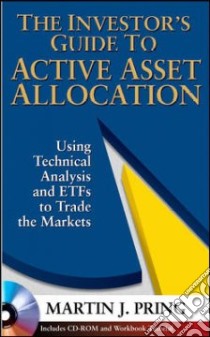- Libreria
- >
- Libri in lingua
- >
- Economia, finanza e management
- >
- Investimenti e titoli
The Investor's Guide to Active Asset Allocation - 9780071466851
Un libro in lingua di Pring Martin J. edito da McGraw-Hill, 2006
- € 41.20
- Il prezzo è variabile in funzione del cambio della valuta d’origine
The Investor's Guide to Active Asset Allocation offers you the background and analytical tools required to take full advantage of the opportunities found in asset allocation, sector rotation, ETFs, and the business cycle.
Written by renowned technical analyst and best-selling author Martin Pring, the book presents Mr. Pring's unique Six Business Cycle Stages, explaining why certain asset categories perform better or worse during different phases of the business cycle, and demonstrating how to use intermarket tools and technical analysis to recognize what business cycle stage the market is in.
Pring shows you how to apply active asset allocation, rotating among sectors and major markets (stocks, bonds, and futures) as the business cycle stage changes, to develop optimum allocation strategies. He focuses on exchange traded funds (ETFs) as the best vehicle for asset allocation rotation, since they are easily traded and have much more flexibility than mutual funds. He also offers specific guidelines for what sectors to be in, depending on the business cycle stage.
The Investor's Guide to Active Asset Allocation provides you with proven investing expertise on:
This dynamic investing resource features a CD-ROM, which contains supplementary information that will help you execute the strategies described in the book. You'll find live links to useful web sites that contain a wide-ranging library of ETFs, database sources, historical data files in Excel format, and a collection of historical multi-colored PowerPoint charts.
An essential tool for improving your analytical skills, The Investor's Guide to Active Asset Allocation shows you how to move from a passive to an active allocation model and explains the link between business cycle and stock market cycle for more effective - and profitable - trading and investing.
Informazioni bibliografiche
- Titolo del Libro in lingua: The Investor's Guide to Active Asset Allocation
- Sottotitolo: Using Intermarket Technical Analysis And Etfs to Trade the Markets
- Lingua: English
- Autore: Pring Martin J.
- Editore: McGraw-Hill
- Collana: McGraw-Hill (Hardcover)
- Data di Pubblicazione: 01 Gennaio '06
- Genere: BUSINESS and ECONOMICS
- Argomenti : Asset allocation Handbooks, manuals, etc Investments Handbooks, manuals, etc Portfolio management Handbooks, manuals, etc
- Pagine: 370
- Dimensioni mm: 228 x 158 x 31
- ISBN-10: 0071466851
- EAN-13: 9780071466851


